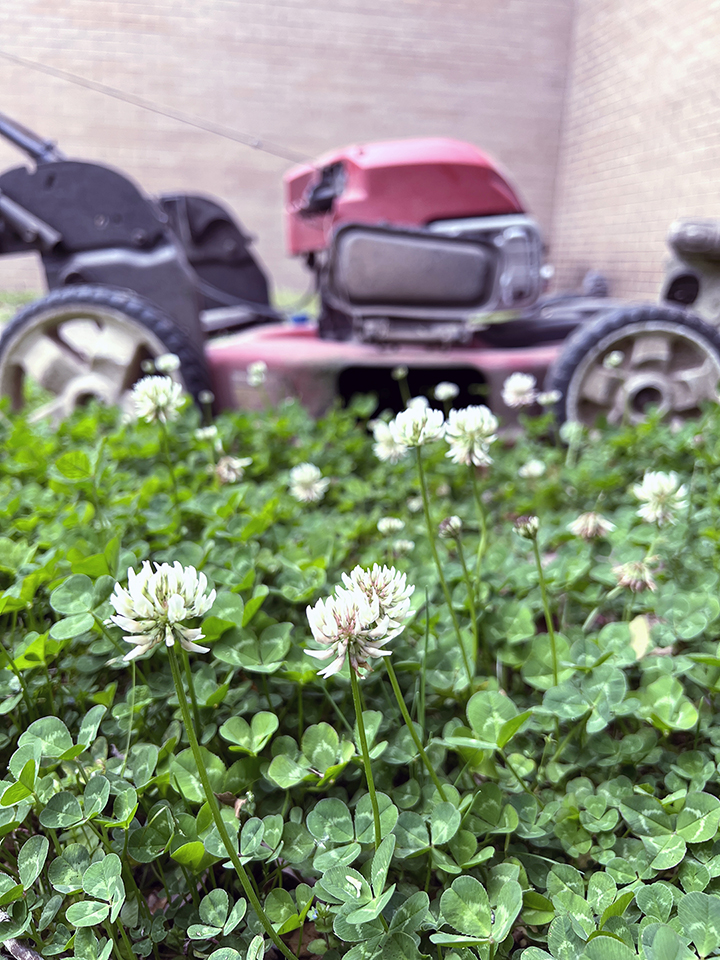‘Lazy' mower approach can help pollinators
Leave early flowers to help bees
April 7, 2022
By Mary Hightower
U of A System Division of Agriculture
Fast facts
- Later-season mowing can help early-season pollinators
- Trees, spring wildflowers an important sources of food
(500 words)
(Newsrooms: with art https://flic.kr/s/aHBqjzJBsV )
LITTLE ROCK — Procrastination in the spring and a little less mowing in the summer may be virtues when it comes to helping pollinators, researchers have found.
The University of Vermont suggests delaying spring mowing so flowers like dandelions can provide early season food resources to pollinators. Those food sources are important to pollinators such as bumble bees, mason bees and others that begin appearing in March.

Early spring mowing can also destroy any chrysalises still clinging to last year’s grass, and any overwintering shelter for later-appearing pollinators, according to the Xerces Society for Invertebrate Conservation.
“Dandelions are weeds to some homeowners, but to foraging bees, they can be a welcome treat in otherwise barren urban lawns,” said Jon Zawislak, assistant professor of apiculture and urban entomology, for the University of Arkansas System Division of Agriculture.
Zawislak said flowers in the dianthus family are very good sources of pollen, as are those of the Virginia creeper. Clovers and lilies are also good spring sources for pollinators.
“While most people never notice the small flowers on this ubiquitous climbing weed, bees certainly do,” he said. “Holly is another plant with small, easily overlooked flowers, but it's starting to bloom right now, and may be covered with bees on a warm day.”
Bees in trees
“Early in the season, flowering trees are very important sources of pollen for bees,” he said. “In particular, maple, willow and ash trees provide lot of nutrition, even though we don't see them as having bright showy flowers.”
“Many things in the Rosaceae family such as pears, crabapple and wild plum, bloom briefly in the spring but with lots of flowers for bees,” Zawislak said. “The exception is Bradford pear, which nobody seems to like, except maybe the people who build parking lots. These are fast growing trees, which makes them weak, and are not attractive to pollinators.”
Mow less
As summer rolls around and the urge to mow more frequently increases, ignore it.
“Research published by the University of Massachusetts Amherst and the U.S. Forest Service suggests that homeowners can help support bee habitat in suburban environments simply by changing lawn-mowing habits,” he said. “Investigators found that taking a ‘lazy lawn mower’ approach and mowing every two weeks rather than weekly could help encourage bee habitat in suburban lawns by allowing flowers to bloom, which helps provide pollinators with more nutritious forage.”
Research Ecologist Susannah Lerman and Joan Milam, adjunct research fellow at UMass and were co-authors of the study “To mow or to mow less: Lawn mowing frequency affects bee abundance and diversity in suburban lawns.”
Milam said she was amazed at both the diversity and abundance of bees their team documented in residential lawns. "It speaks to the value of the untreated lawn to support wildlife," she said.
Research ecologist Susannah Lerman said the conclusions are “a reminder that sustainability begins at home, and in this case involves doing less for more buzz."
The Cooperative Extension Service has many beekeeping resources online or contact your county extension office.
To learn more about Division of Agriculture research, visit the Arkansas Agricultural Experiment Station website: https://aaes.uark.edu. Follow on Twitter at @ArkAgResearch. To learn more about the Division of Agriculture, visit https://uada.edu/. Follow us on Twitter at @AgInArk. To learn about extension programs in Arkansas, contact your local Cooperative Extension Service agent or visit www.uaex.uada.edu.
About the Division of Agriculture
The University of Arkansas System Division of Agriculture’s mission is to strengthen agriculture, communities, and families by connecting trusted research to the adoption of best practices. Through the Agricultural Experiment Station and the Cooperative Extension Service, the Division of Agriculture conducts research and extension work within the nation’s historic land grant education system.
The Division of Agriculture is one of 20 entities within the University of Arkansas System. It has offices in all 75 counties in Arkansas and faculty on five system campuses.
Pursuant to 7 CFR § 15.3, the University of Arkansas System Division of Agriculture offers all its Extension and Research programs and services (including employment) without regard to race, color, sex, national origin, religion, age, disability, marital or veteran status, genetic information, sexual preference, pregnancy or any other legally protected status, and is an equal opportunity institution.
# # #
Media contact: Mary Hightower
mhightower@uada.edu